EasyDCIM Dedicated Servers For WHMCS
| Line 180: | Line 180: | ||
==Configuration of Server== | ==Configuration of Server== | ||
{| | {| | ||
| − | |style="padding: 10px 0px 15px 15px;"|''' | + | |style="padding: 10px 0px 15px 15px;"|'''4. Now, we will show you how to configure a new product.'''<br/> |
Go to '' 'Setup' → 'Products/Services' → 'Servers' '' and press '' 'Add New Server' '' button. | Go to '' 'Setup' → 'Products/Services' → 'Servers' '' and press '' 'Add New Server' '' button. | ||
|} | |} | ||
| Line 187: | Line 187: | ||
|} | |} | ||
{| | {| | ||
| − | |style="padding: 0px 0px 15px 15px;"|''' | + | |style="padding: 0px 0px 15px 15px;"|'''5. Next, choose '' 'EasyDCIM' '' from '' 'Type' '' dropdown menu.<br/> |
Fill in your server name, IP address, username and password and press '' 'Save Changes'.''<br/> | Fill in your server name, IP address, username and password and press '' 'Save Changes'.''<br/> | ||
Password can be found in your EasyDCIM administrator user profile listed as '' 'API Key'.'' | Password can be found in your EasyDCIM administrator user profile listed as '' 'API Key'.'' | ||
| Line 195: | Line 195: | ||
|} | |} | ||
{| | {| | ||
| − | |style="padding: 0px 0px 15px 15px;"|''' | + | |style="padding: 0px 0px 15px 15px;"|'''6. After configuring your server, you can check connection.'''<br/> |
In order to check connection with a EasyDCIM server, edit server configuration and press '' 'Test Connection' '' as shown on the screen below. | In order to check connection with a EasyDCIM server, edit server configuration and press '' 'Test Connection' '' as shown on the screen below. | ||
|} | |} | ||
| Line 202: | Line 202: | ||
|} | |} | ||
{| | {| | ||
| − | |style="padding: 0px 0px 20px 15px;"|''' | + | |style="padding: 0px 0px 20px 15px;"|'''7. It is time to create a server group, to do so click on '' 'Create Server Group'.'' |
|} | |} | ||
{| | {| | ||
| Line 208: | Line 208: | ||
|} | |} | ||
{| | {| | ||
| − | |style="padding: 0px 0px 20px 15px;"|''' | + | |style="padding: 0px 0px 20px 15px;"|'''8. Enter name, click on your previously created server, press '' 'Add' '' and afterwards '' 'Save Changes'.''''' |
|} | |} | ||
{| | {| | ||
| Line 216: | Line 216: | ||
==Configuration of Product== | ==Configuration of Product== | ||
{| | {| | ||
| − | |style="padding: 10px 0px 15px 15px;"|''' | + | |style="padding: 10px 0px 15px 15px;"|'''9. In order to create and configure a product go to '' 'Setup' → 'Products/Services' → 'Products/Services'.'''''<br/> |
Click on '' 'Create a New Group'.'' | Click on '' 'Create a New Group'.'' | ||
|} | |} | ||
| Line 223: | Line 223: | ||
|} | |} | ||
{| | {| | ||
| − | |style="padding: 0px 0px 20px 15px;"|''' | + | |style="padding: 0px 0px 20px 15px;"|'''10. Enter product group name and press '' 'Save Changes'.''''' |
|} | |} | ||
{| | {| | ||
| Line 229: | Line 229: | ||
|} | |} | ||
{| | {| | ||
| − | |style="padding: 0px 0px 15px 15px;"|''' | + | |style="padding: 0px 0px 15px 15px;"|'''11. When you have a product group, you can assign your product to it.'''<br/> |
To create a product click on '' 'Create a New Product'.'' | To create a product click on '' 'Create a New Product'.'' | ||
|} | |} | ||
| Line 236: | Line 236: | ||
|} | |} | ||
{| | {| | ||
| − | |style="padding: 0px 0px 15px 15px;"|''' | + | |style="padding: 0px 0px 15px 15px;"|'''12. Afterwards, choose your product group, enter your product name and then press '' 'Continue'.''''' |
|} | |} | ||
{| | {| | ||
| Line 242: | Line 242: | ||
|} | |} | ||
{| | {| | ||
| − | |style="padding: 0px 0px 15px 15px;"|''' | + | |style="padding: 0px 0px 15px 15px;"|'''13. Now go to '' 'Module Settings' '' section, choose both '' 'EasyDCIM' '' and your previously created server group from dropdown menus.<br/> |
Next, '' 'Save Changes'.''''' | Next, '' 'Save Changes'.''''' | ||
|} | |} | ||
| Line 249: | Line 249: | ||
|} | |} | ||
{| | {| | ||
| − | |style="padding: 0px 0px 15px 15px;"|''' | + | |style="padding: 0px 0px 15px 15px;"|'''14. Before configuring product, set up EasyDCIM cron job which can be found here. |
|} | |} | ||
{| | {| | ||
| Line 255: | Line 255: | ||
|} | |} | ||
{| | {| | ||
| − | |style="padding: 0px 0px 20px 15px;"|''' | + | |style="padding: 0px 0px 20px 15px;"|'''15. Module configuration is partially non-mandatory. The server will be assigned basing on the defined configuration and matching only the filled out options. |
'''Default Options:''' | '''Default Options:''' | ||
*Model (required) - EasyDCIM server model | *Model (required) - EasyDCIM server model | ||
Revision as of 16:00, 19 May 2017
Contents |
About EasyDCIM Dedicated Servers For WHMCS
| EasyDCIM Dedicated Servers For WHMCS will allow you to move provisioning and management of EasyDCIM servers directly to your WHMCS. Module will let your clients overview and manage their servers directly from your client area. |
- Admin Area Features:
| ✔ Create/Terminate/Suspend/Unsuspend Server |
| ✔ Boot/Reboot/Shutdown Server |
| ✔ Change Server SSH Access Details |
| ✔ View Server Details |
| ✔ View Server Resource Usage Graphs |
| ✔ Generate Default Configurable Options |
| ✔ Configure Server: |
| ✔ Server Model |
| ✔ Server Location |
| ✔ OS Template |
| ✔ Server Resources |
| ✔ Toggle Automatic Order Accepting And Server Matching |
| ✔ Define Required Devices |
| ✔ Define Required Item Models: |
| ✔ HDD Model |
| ✔ SSD Model |
| ✔ RAM Model |
| ✔ CPU Model |
| ✔ Define Client Area Features |
| ✔ Control Service Access Level |
| ✔ One Click Login To EasyDCIM: |
| ✔ User Control Panel |
| ✔ Admin Panel |
| ✔ Toggle Debug Mode |
- Client Area Features:
| ✔ Boot/Reboot/Shutdown Server |
| ✔ Change Server SSH Password |
| ✔ View Server Details |
| ✔ Reinstall Server OS Using OS Templates |
| ✔ View Server Resource Usage Graphs |
| ✔ View Traffic Statistics |
| ✔ One Click Login To User Control Panel |
- General Info:
| ✔ Multi-Language Support |
| ✔ Supports EasyDCIM v1.2.0 and Later |
| ✔ Supports PHP 5.4 Up To PHP 7 |
| ✔ Supports WHMCS Templates Five and Six |
| ✔ Supports WHMCS V6 and V7 |
- Configurable Options:
| ✔ Server Model |
| ✔ Server Location |
| ✔ OS Template |
| ✔ Monthly Traffic Limit |
| ✔ Additional IP Addresses |
| ✔ HDD Size |
| ✔ SSD Size |
| ✔ RAM Size |
| ✔ CPU Cores |
Installation and Configuration
| This tutorial will show you how to successfully install and configure EasyDCIM For WHMCS. We will guide you step by step through the whole installation and configuration process. |
Installation
| 1. Log in to your client area and download EasyDCIM For WHMCS. |
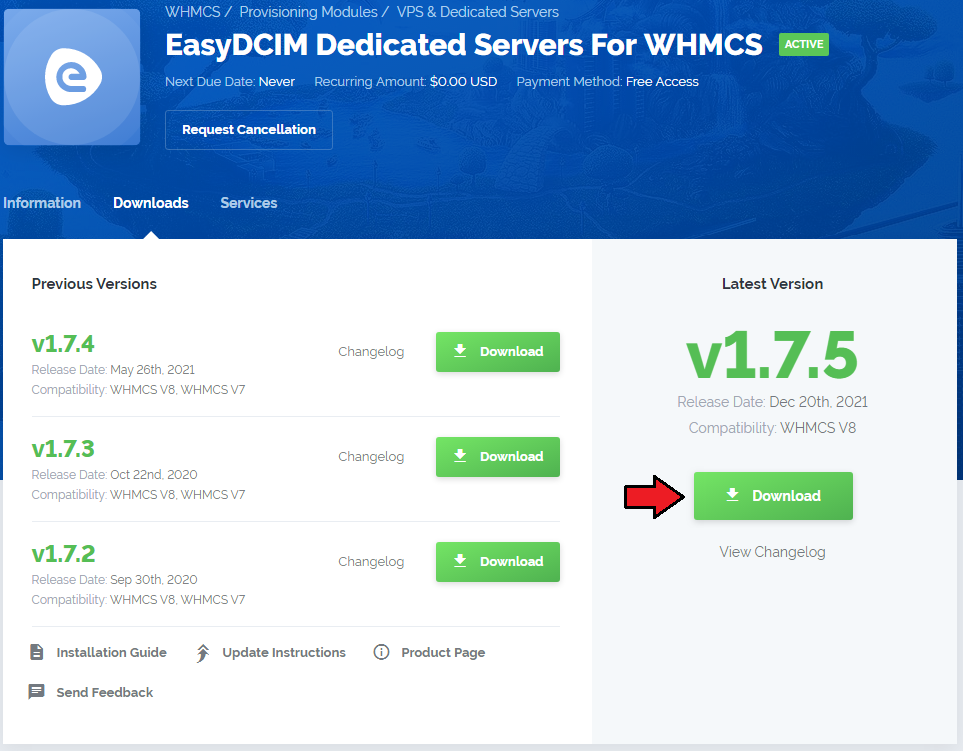
|
| 2. In the downloaded file you will find two packages that support different PHP versions. As presented on the screen below, the first one is dedicated to PHP 7, while the second one is aimed at PHP 5.4 up to PHP 5.6. Note: You can check current PHP version in your WHMCS. To do so proceed to 'Utilities' → 'System' → 'PHP Info'. |

|
| 3. Extract the downloaded file and choose the one with the right PHP version. Upload and extract the PHP file into the main WHMCS directory. The content of PHP version files should look like this. |
Configuration of Server
| 4. Now, we will show you how to configure a new product. Go to 'Setup' → 'Products/Services' → 'Servers' and press 'Add New Server' button. |
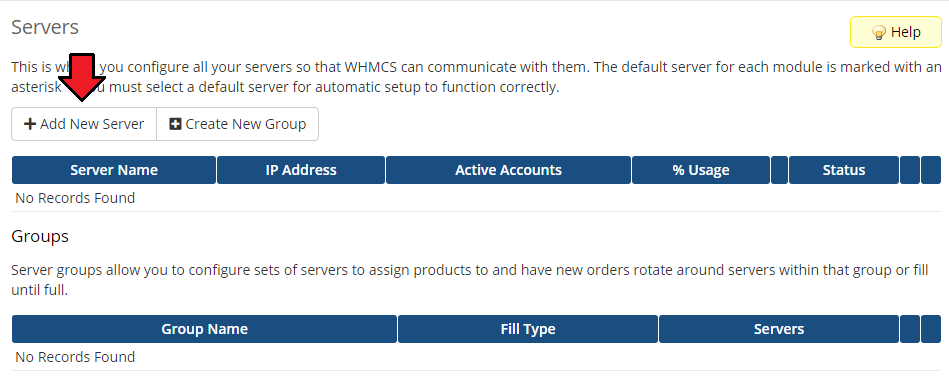
|
| 5. Next, choose 'EasyDCIM' from 'Type' dropdown menu. Fill in your server name, IP address, username and password and press 'Save Changes'. |
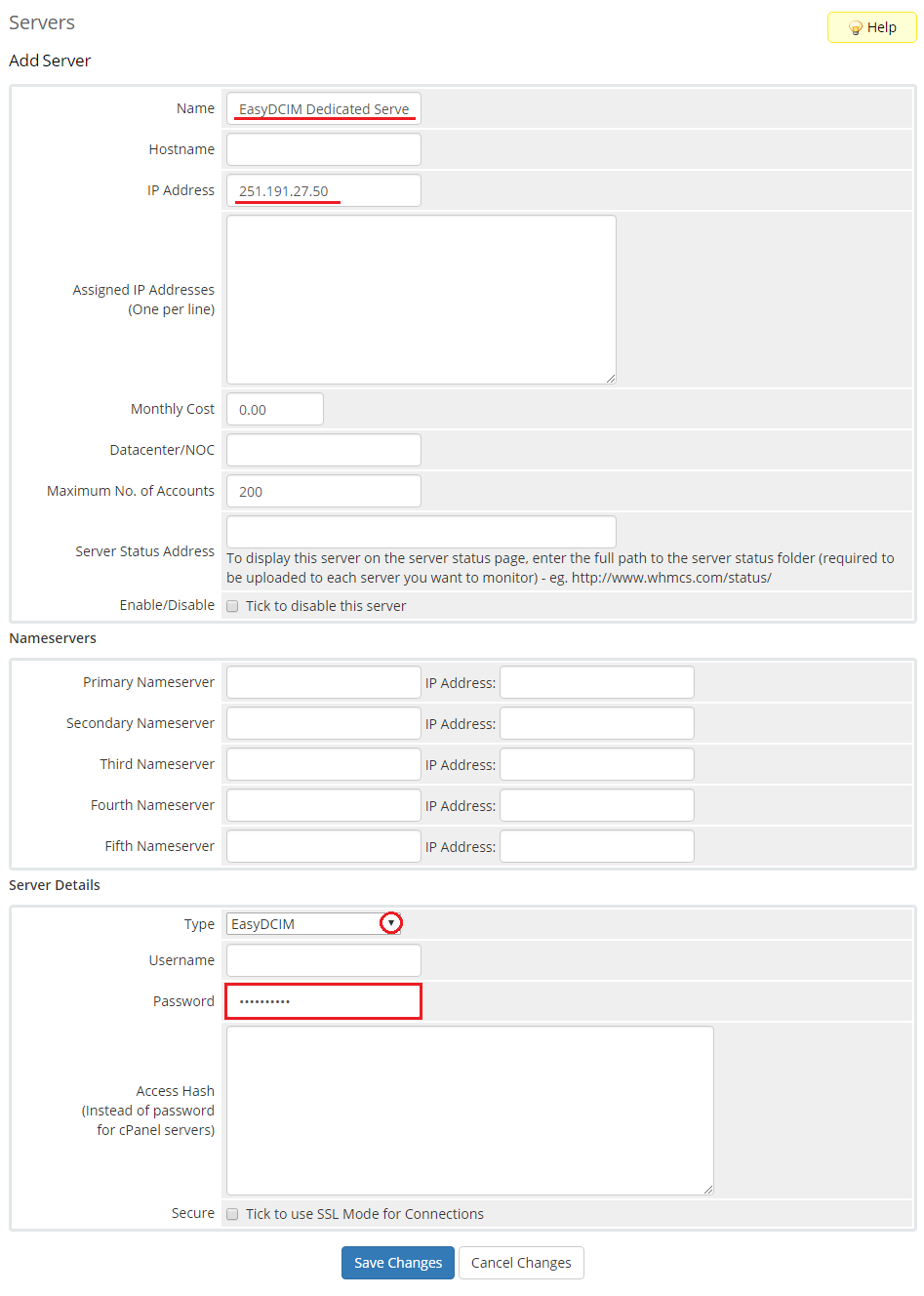
|
| 6. After configuring your server, you can check connection. In order to check connection with a EasyDCIM server, edit server configuration and press 'Test Connection' as shown on the screen below. |
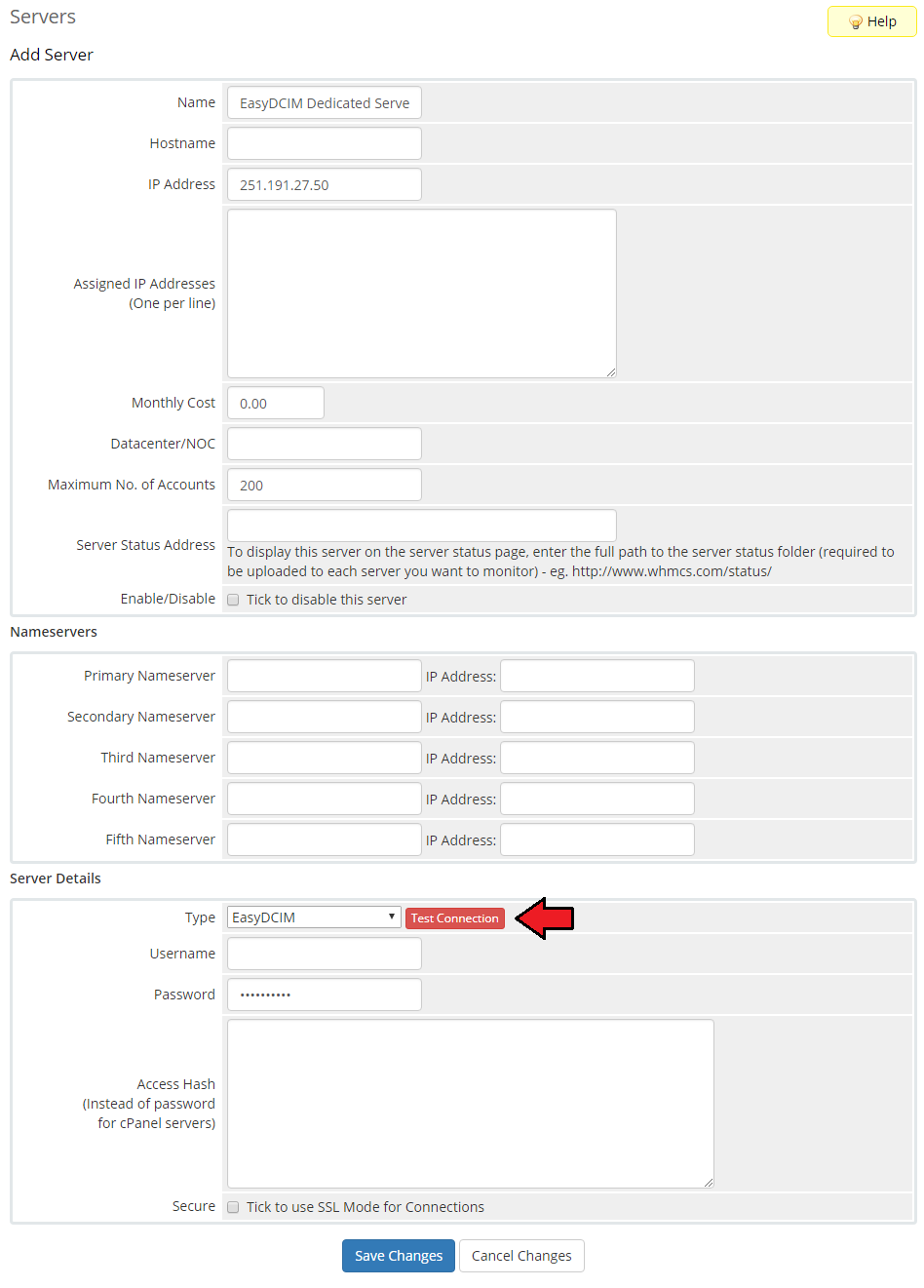
|
| 7. It is time to create a server group, to do so click on 'Create Server Group'. |
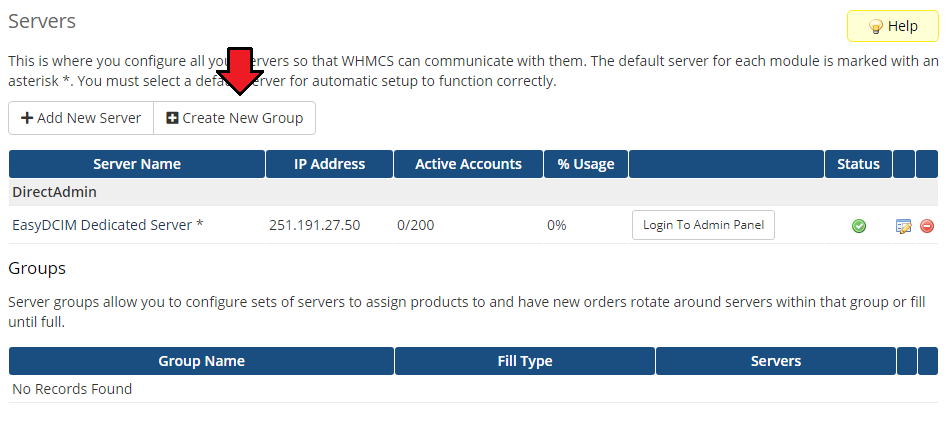
|
| 8. Enter name, click on your previously created server, press 'Add' and afterwards 'Save Changes'. |
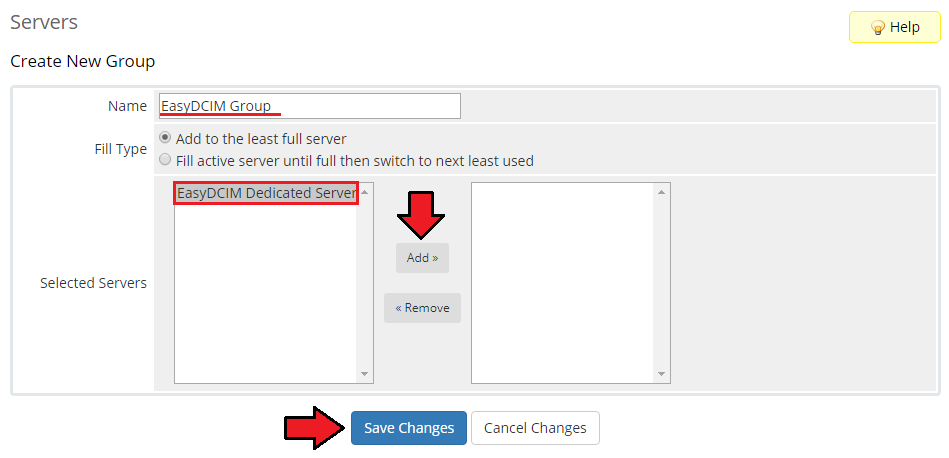
|
Configuration of Product
| 9. In order to create and configure a product go to 'Setup' → 'Products/Services' → 'Products/Services'. Click on 'Create a New Group'. |

|
| 10. Enter product group name and press 'Save Changes'. |
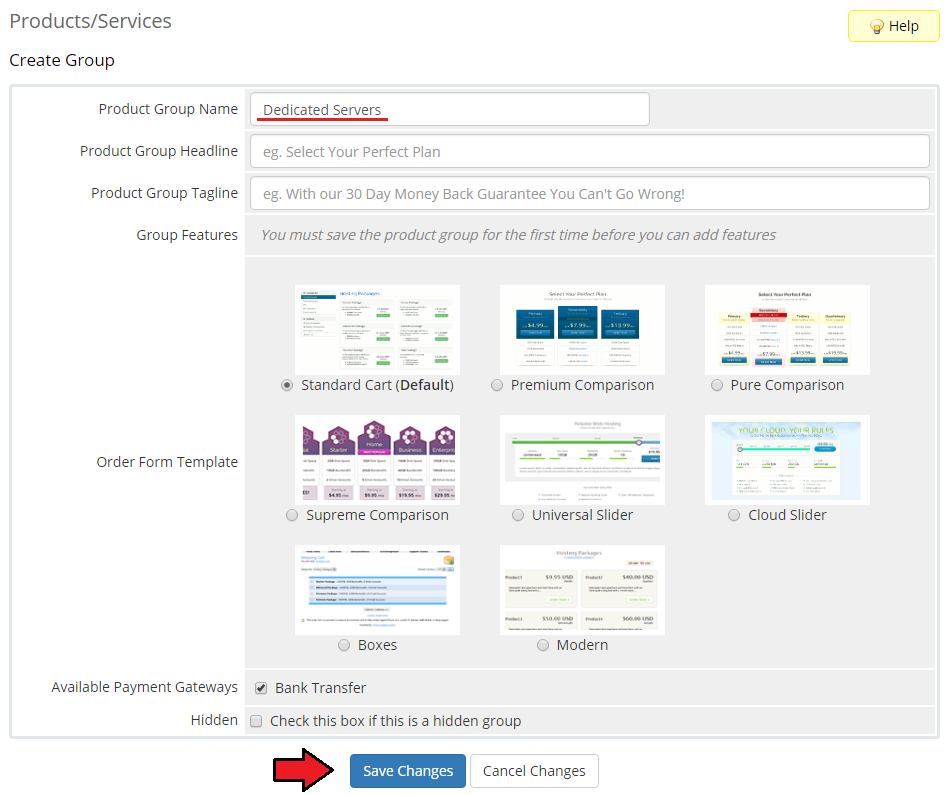
|
| 11. When you have a product group, you can assign your product to it. To create a product click on 'Create a New Product'. |

|
| 12. Afterwards, choose your product group, enter your product name and then press 'Continue'. |

|
| 13. Now go to 'Module Settings' section, choose both 'EasyDCIM' and your previously created server group from dropdown menus. Next, 'Save Changes'. |
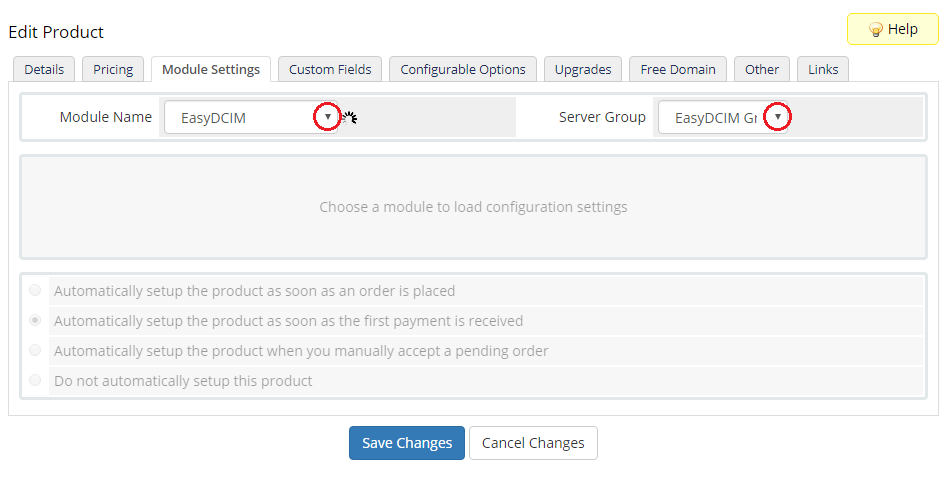
|
| 14. Before configuring product, set up EasyDCIM cron job which can be found here. |
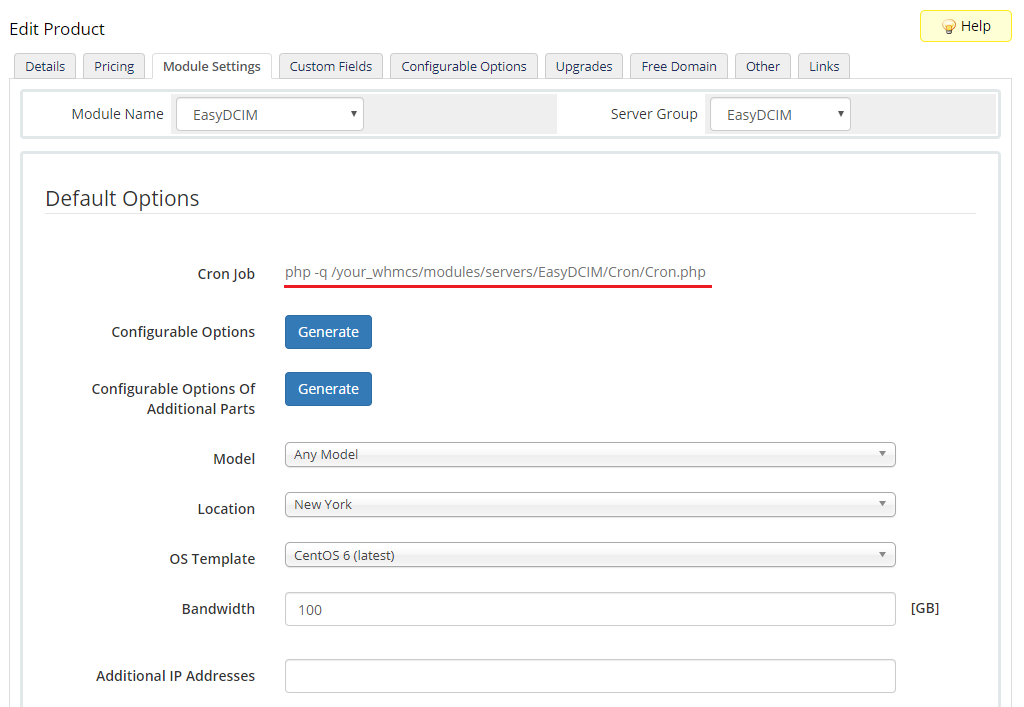
|
| 15. Module configuration is partially non-mandatory. The server will be assigned basing on the defined configuration and matching only the filled out options.
Default Options:
Product Configuration
Items Model
Client Area Features
Service Actions
|

|
| 15. Now, optionally you can generate default configurable options to allow orders tailored to your clients needs. We recommend viewing and modifying them to fit your provisioning capabilities. You can find them under 'Setup' → 'Products/Services' → 'Configurable Options'. |
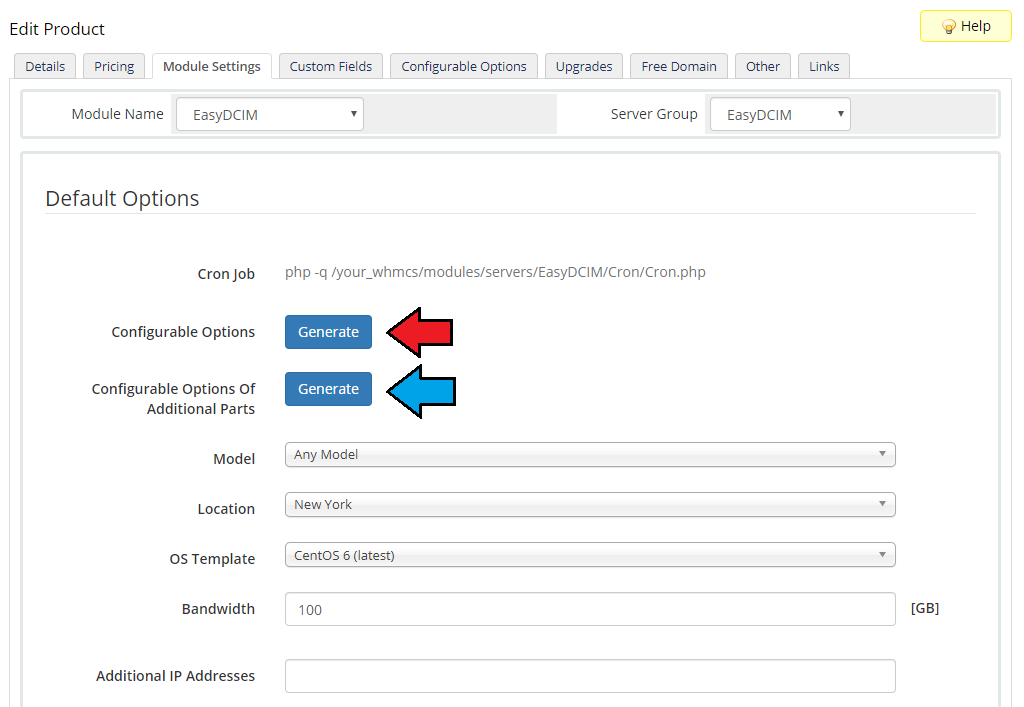
|
Management
| In this section we will show you all the possibilities of EasyDCIM For WHMCS. Our module allows you to offer EasyDCIM via your WHMCS system. |
Admin Area
|
As soon as you set up a server for a client, you can request various actions and view server details from WHMCS admin area. |
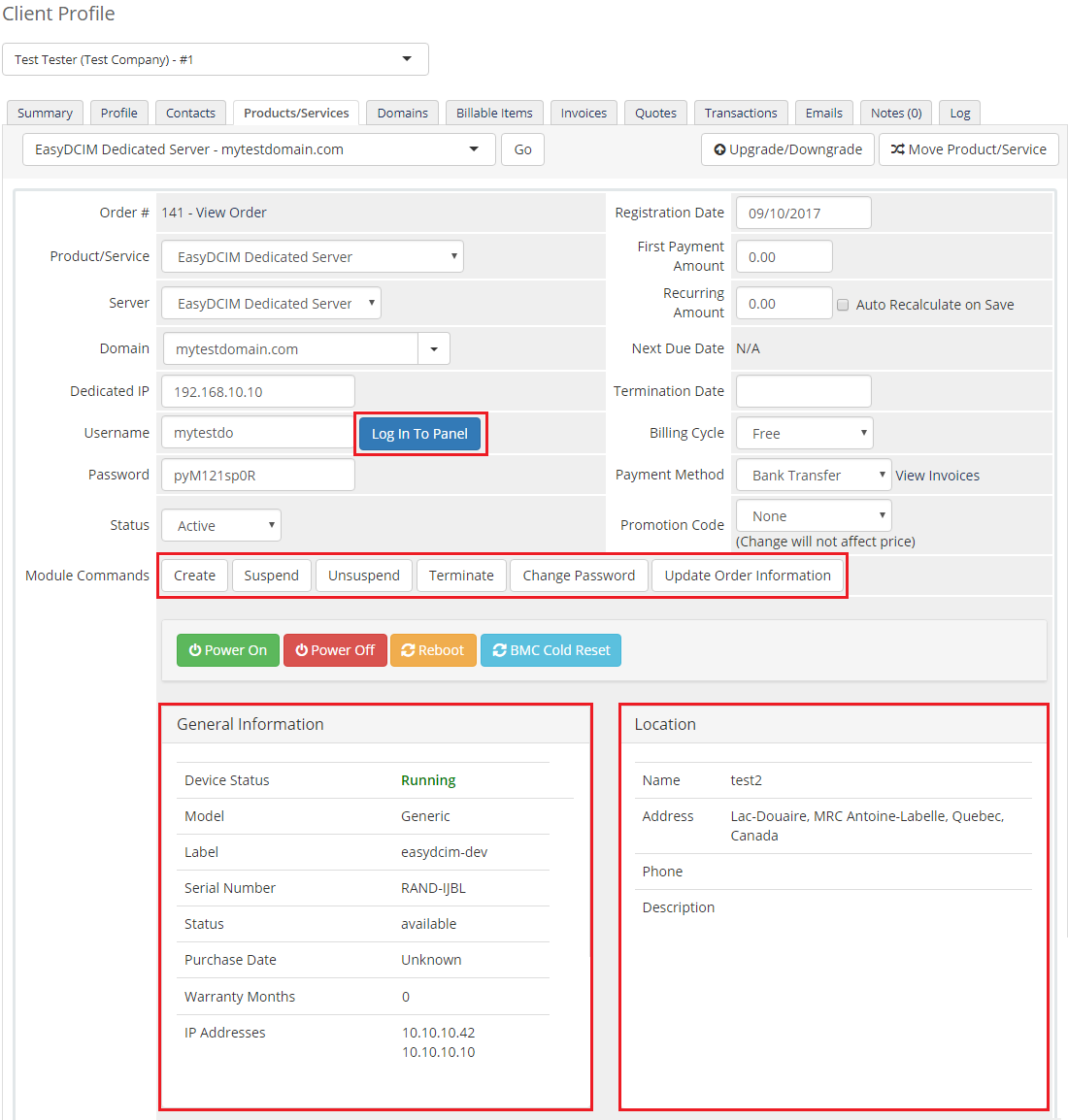
|
| Our module allows you to boot/reboot/shutdown server as well as view its details. |
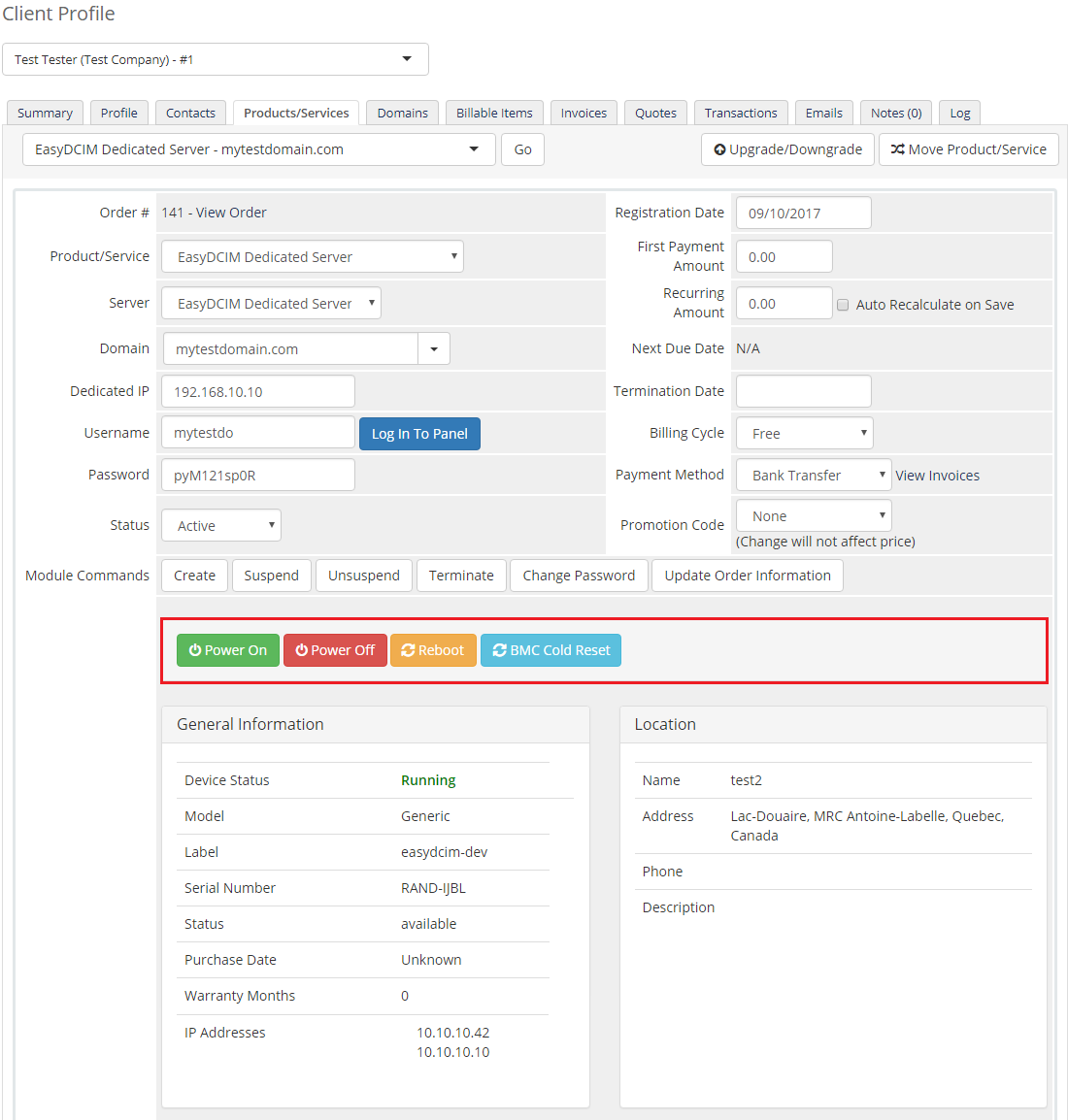
|
| Below them, there are various usage graphs are available at your disposal. |
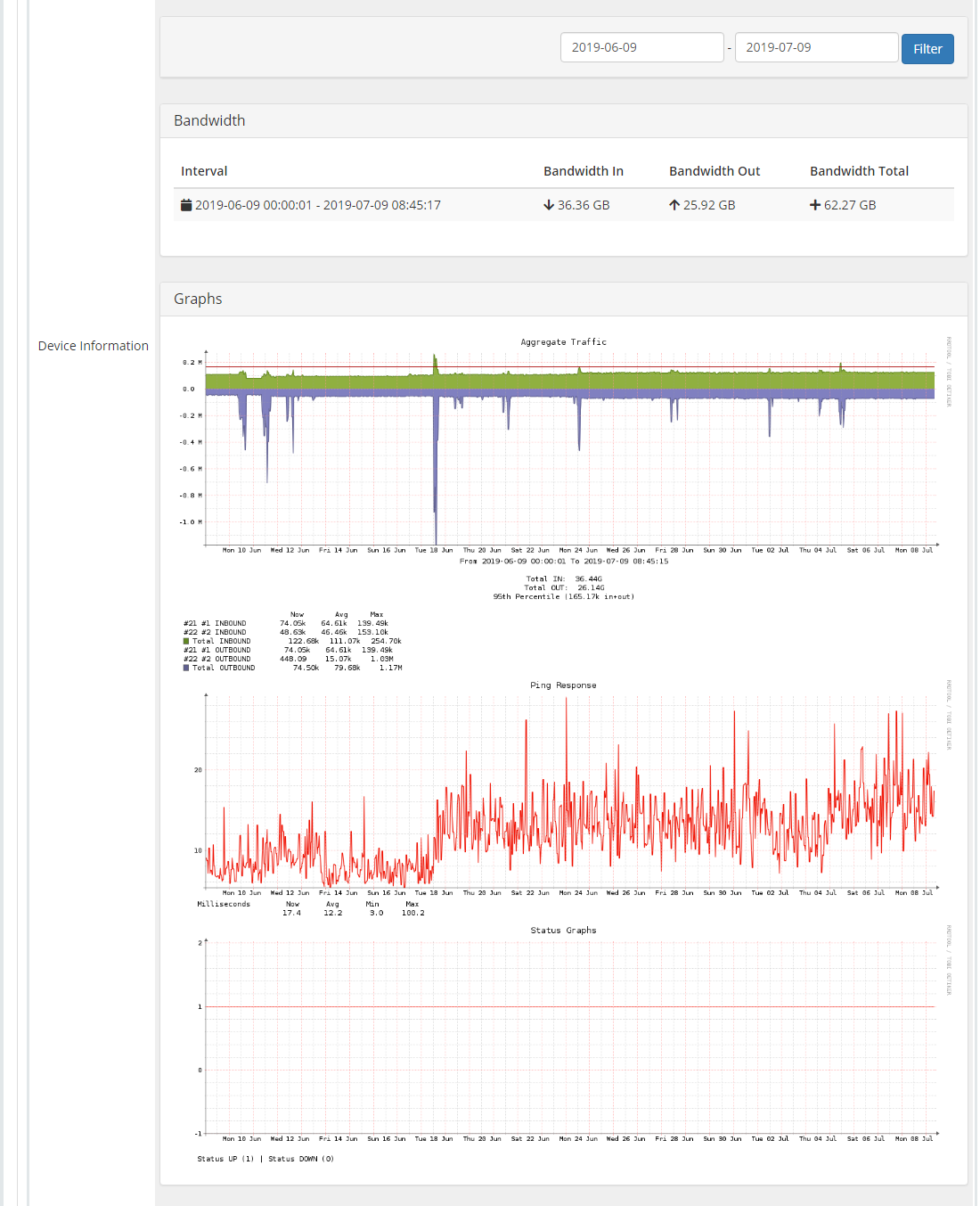
|
Client Area
| In the client area of the module your clients can view all details concerning their servers as well as manage the status and log in to their EasyDCIM control panel. |
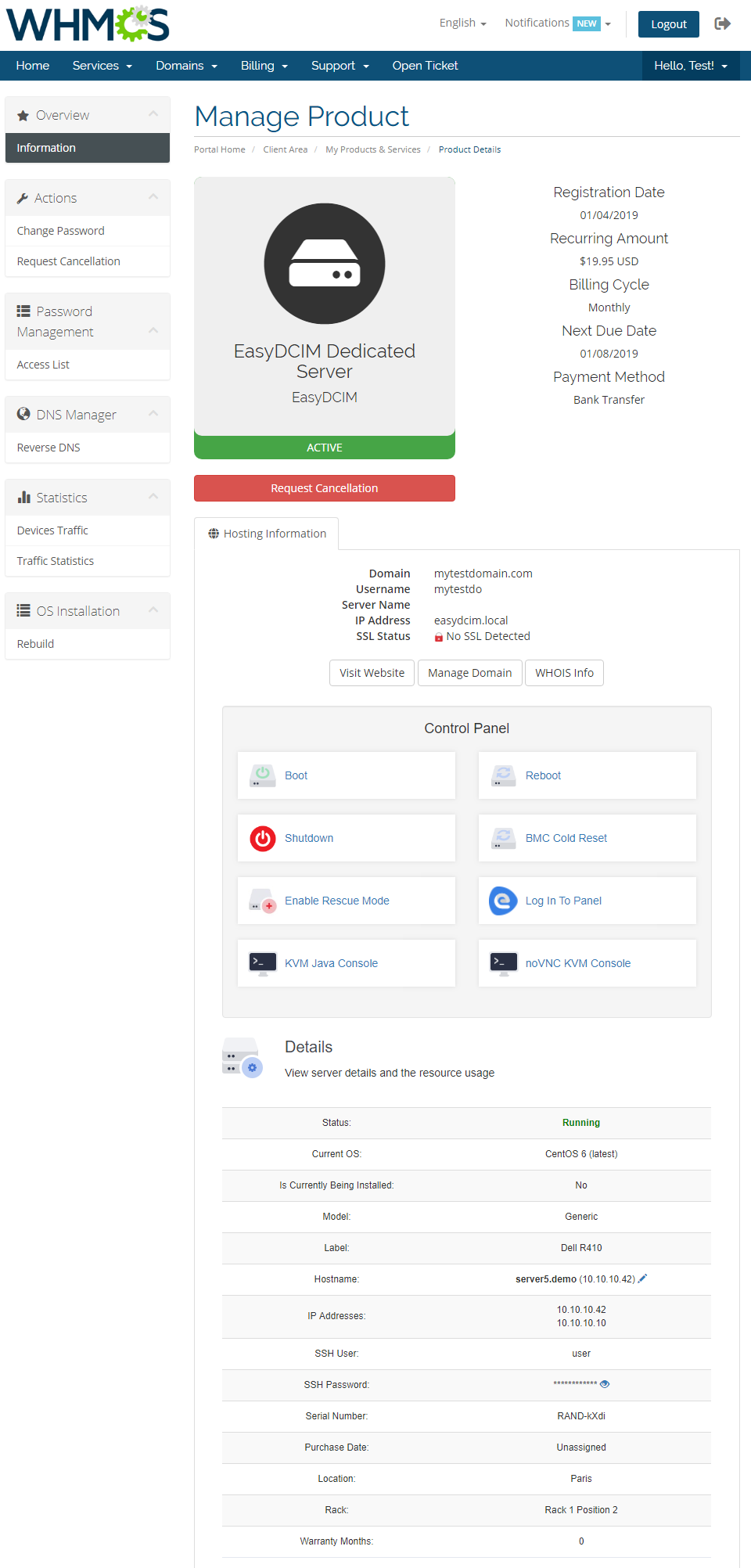
|
| Additionally, below you can find numerous usage graphs. |
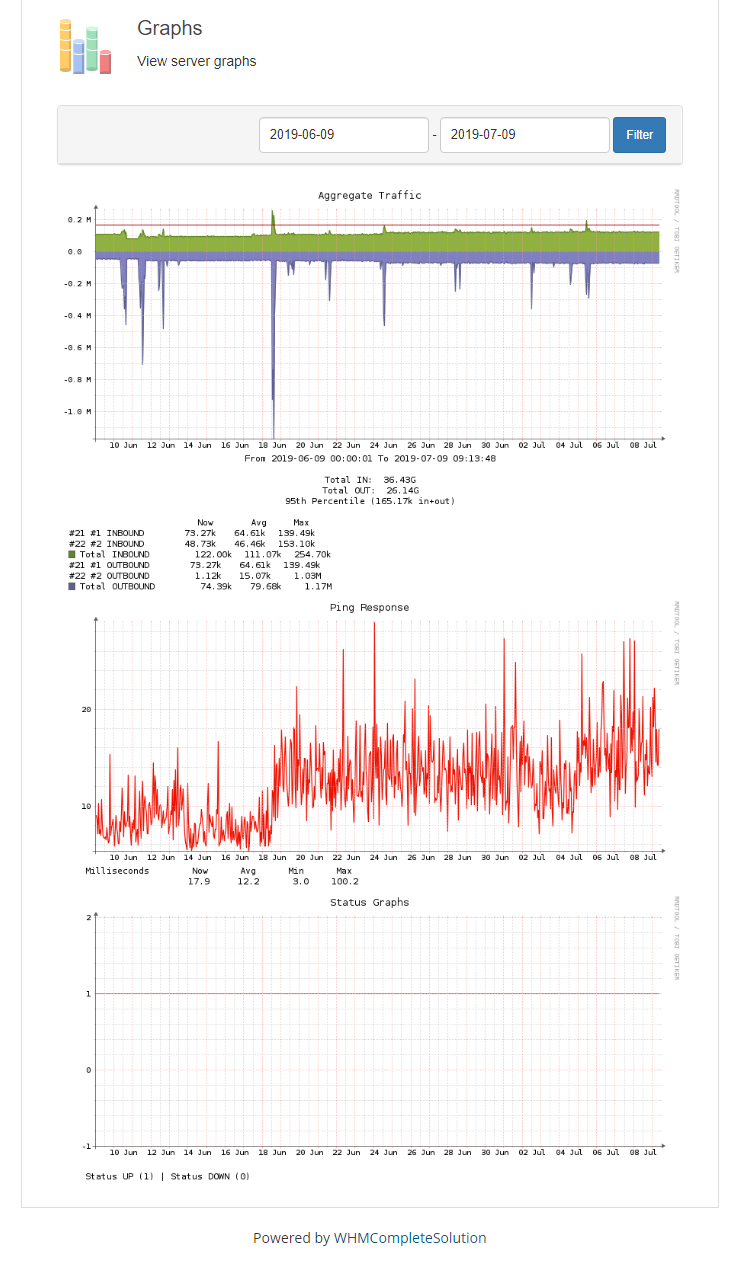
|
| You can also view information about traffic billing. |
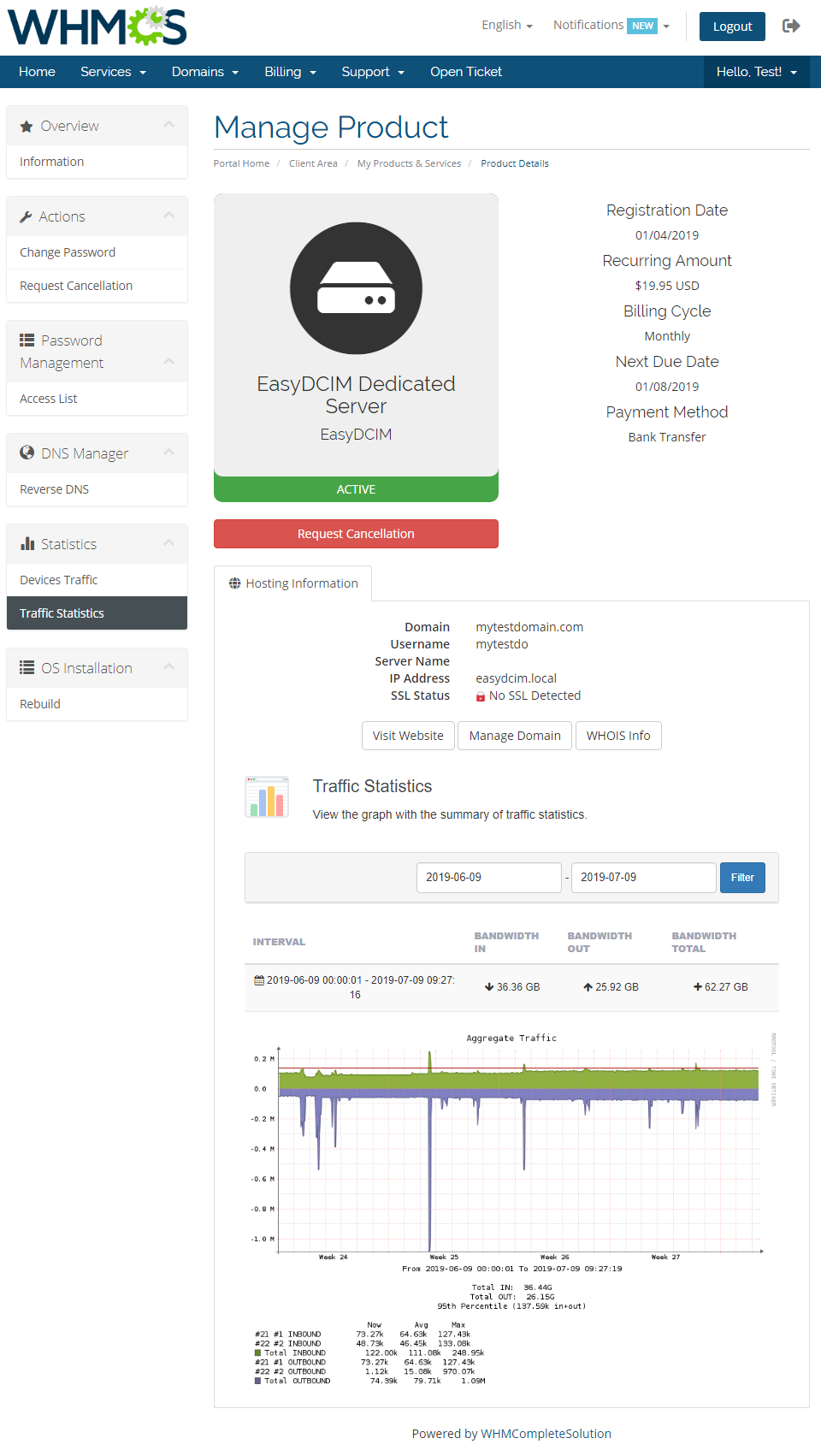
|
| As well as reinstall OS on your server. |
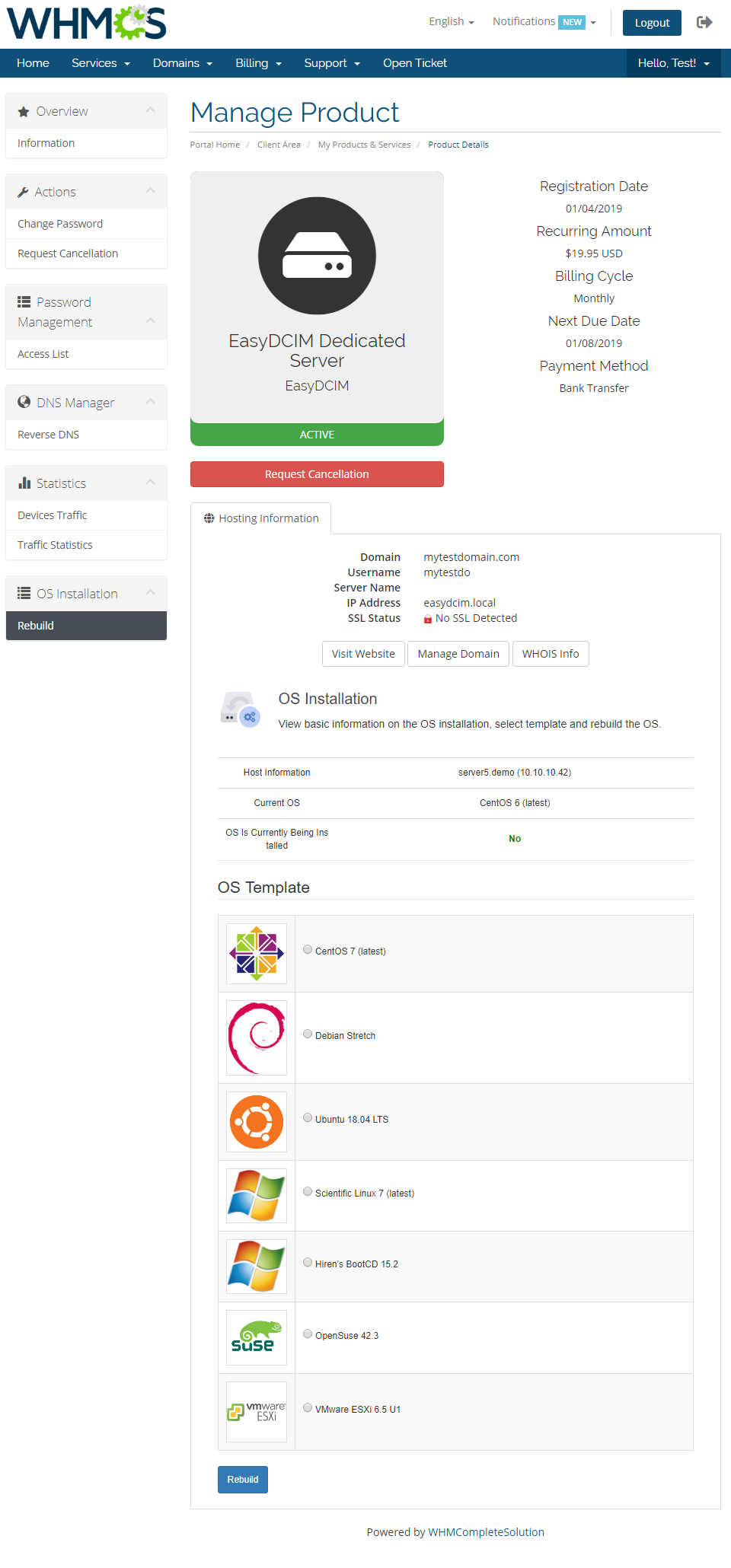
|
| Moreover, it is possible to control your reverse DNS. You can either edit the already existing records or create new ones. |
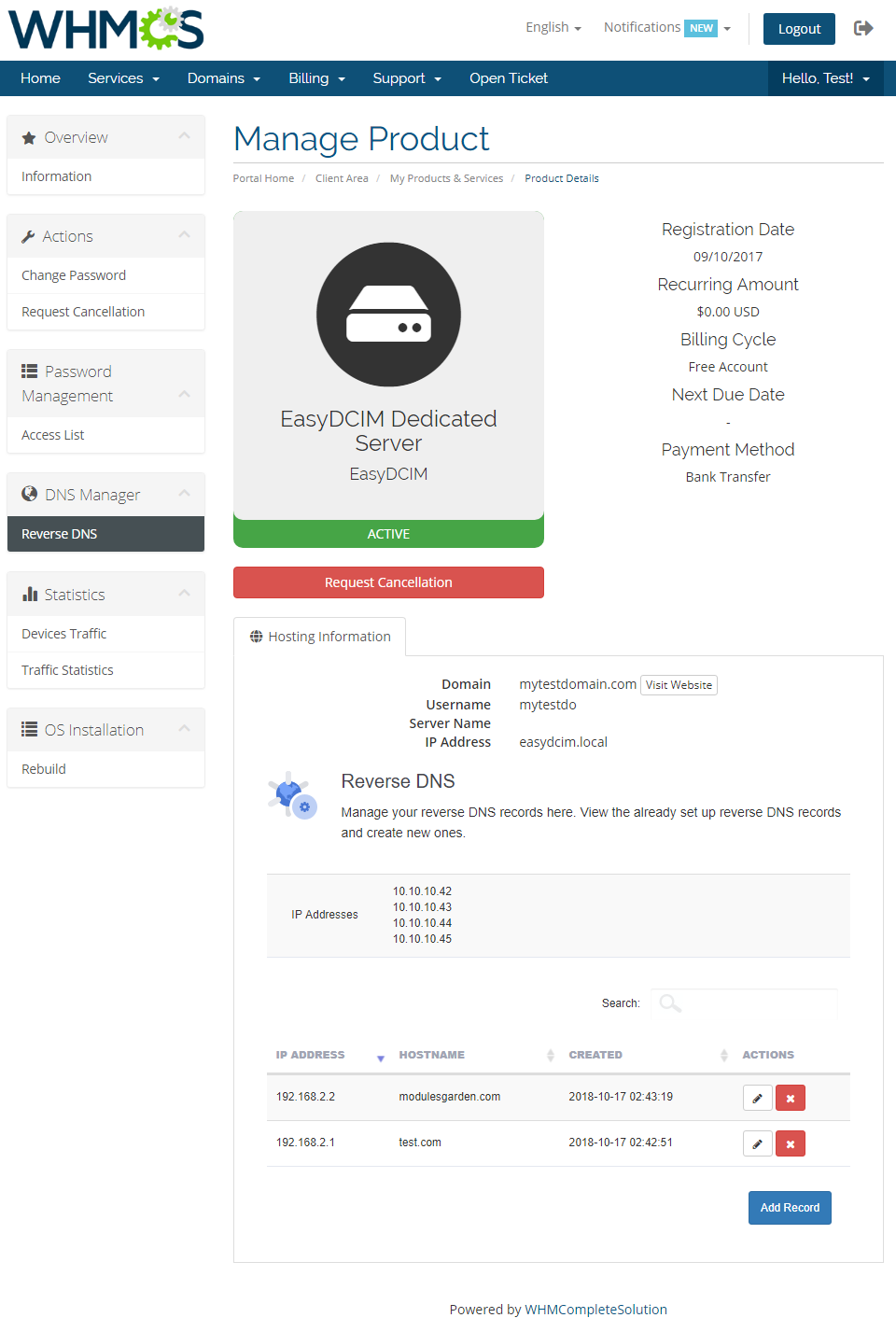
|
| To create a record just fill in the necessary information. |

|
| Your newly created record will appear on the list. |
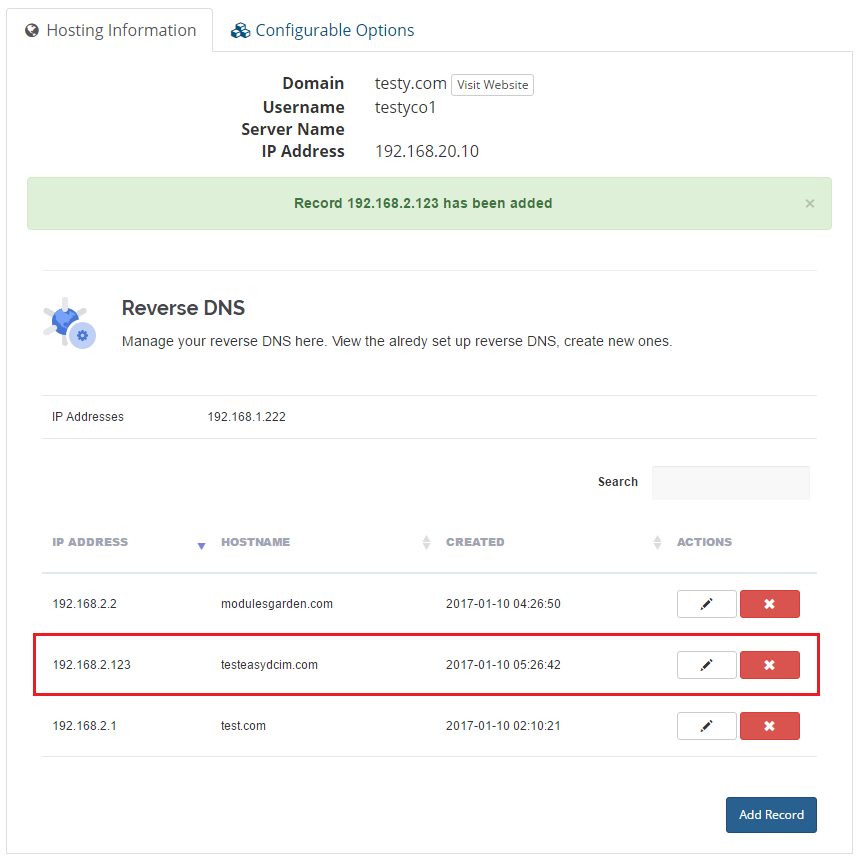
|
Tips
| 1. Note that two identical orders may result in assigning server with slightly different parameters.
It is the result of the way EasyDCIM server matching works. It matches a server basing on the resources and models mentioned in the order, without considering other resources. |
| 2. As this server supports templates system, any changes made in the server's templates files will be saved after the upgrade process. |
Common Problems
| 1. When you have problems with connection, check whether your SELinux or firewall does not block ports. |